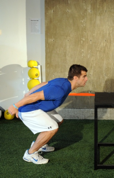Kettlebell Training With Young Athletes
By Pamela MacElree MS
Just like every other training modality, kettlebells also have training and movement progressions.
I find it ironic that we often see people approaching kettlebell training far differently than they would barbell training or even the use of a dumbbell. Everything has a progression, always. I’ve talked about it before, you wouldn’t give someone additional weight in a squat if their bodyweight squat has poor form and you especially wouldn’t give them a weight to use in squats if they never squatted before.
If this is the case why would we automatically hand someone a kettlebell and show them how to do snatches if they had never done one before, if they had never used one before, or if they had never done any other similar movements before. We don’t.
This is where progressions come in to play when training young athletes. Progressions are highly important to understand and know to ensure that our clients and athletes both have good form and once they have maintained good form, can safely make increases in weight.
Since I mentioned kettlebell snatches earlier, let’s use them as the example. Keep in mind that I am not teaching how to do a kettlebell snatch, I am showing you the progression on where to start when first teaching the snatch.
Let’s take a look at things in reverse order:
- Prior to doing kettlebell snatches we should ensure that being able to do a one arm kettlebell high pull is a proficient movement pattern.
- Prior to doing one arm kettlebell high pulls, we want to teach and learn two arm kettlebell high pulls.
- Prior to doing two arm kettlebell high pulls, we will teach the kettlebell Romanian deadlift.
- Prior to learning the kettlebell Romanian deadlift we teach the good morning stretch.
As you can see there are several steps that need to happen before teaching young athletes a kettlebell snatch. The purpose here is to not actually teach you the kettlebell snatch but to show you the movement patterns that need to be learned and perfected prior to attempting the snatch.
The good morning stretch shows us that our athletes understand the hip hinging process of moving the hips back in space, rather than down toward the floor as in a squat.
The Romanian deadlift follows the same hip hinging pattern as the good morning stretch with external load, slow and controlled. When learning the Romanian deadlift you start with two hands on the kettlebell and move to one.
After mastering the slow and controlled movements, we will move into the more dynamic explosive exercises of the two arm and one arm high pulls and finally progressing to the snatch.
Here’s a video to help you coach young athletes bring all of these kettlebell movements together :



